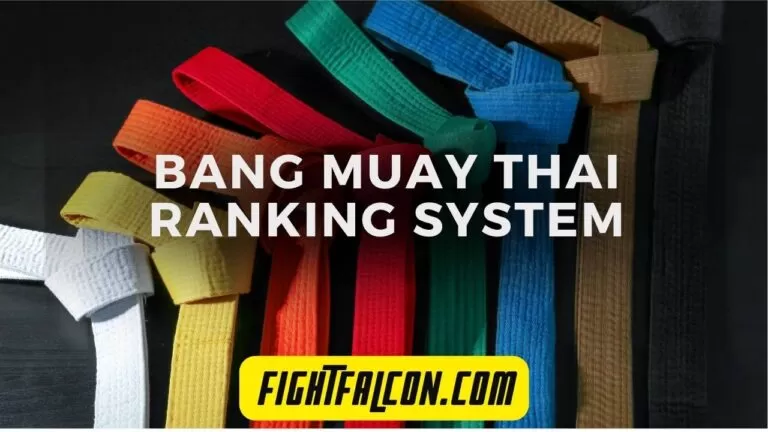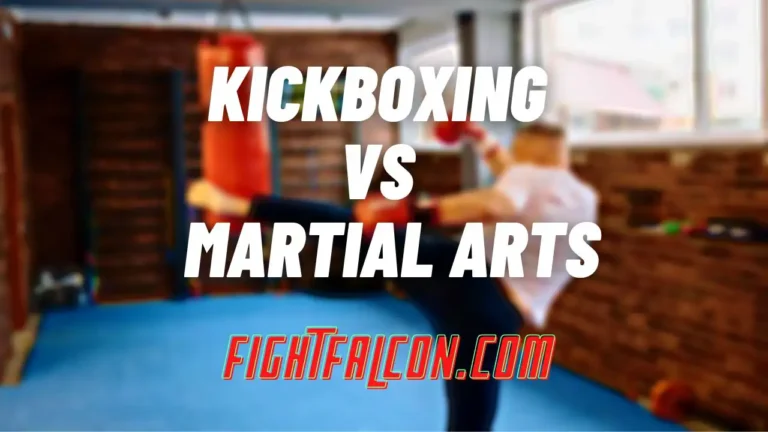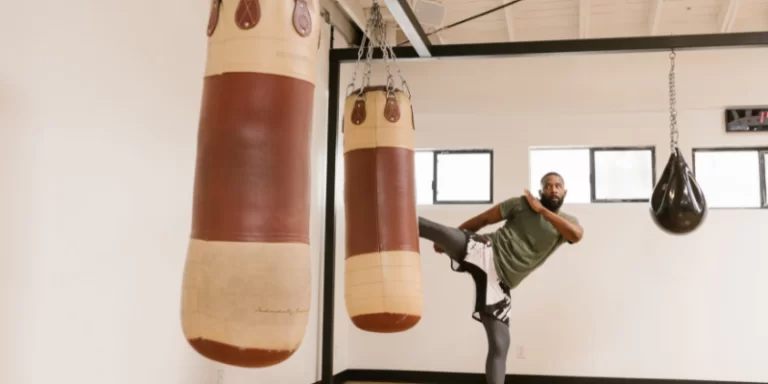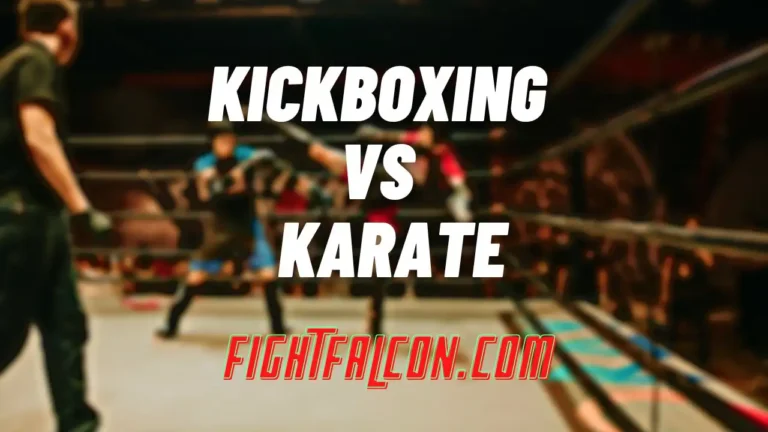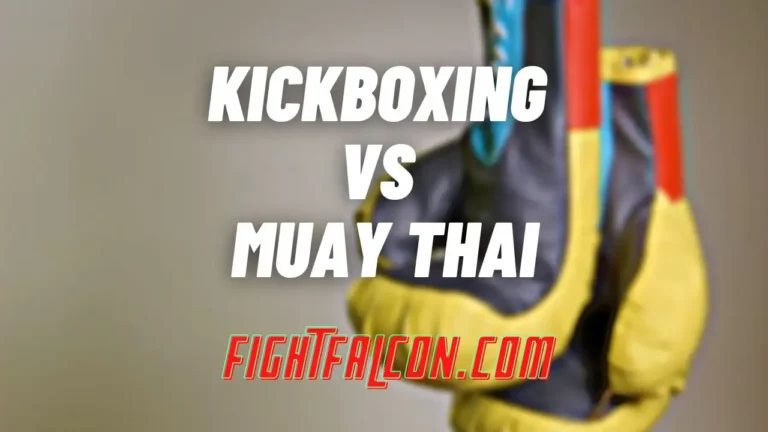20 Different Martial Arts Types – Revealed All
The world of Martial Arts is bigger than you can imagine. It covers a huge array of fighting styles originating from places worldwide. Each Martial Art has its own perspective and rules and regulations for fights. Some are safe, while others are really hard to master.
From Tai Chi to Brazilian Jiu-Jitsu, each style has something unique and beneficial to offer its practitioners.
I’ll walk you through every martial art’s history, subculture, and realistic elements so you get complete insights into it. Let’s get started.
Here is a quick list of the top 20 types of martial arts with a quick definition of each. However, below this table, I’ve discussed each type in detail.
| No. | Martial Art Type | About |
|---|---|---|
| 01. | Muay Thai | Muay Thai, or “The Art of Eight Limbs,” is a potent Thai martial art known for using fists, feet, knees, and elbows in combat, steeped in a rich historical legacy. |
| 02. | Kung Fu | Traditional Kung Fu, originating in China, emphasizes offense and defense techniques inspired by animal movements, fostering determination and a connection to nature. |
| 03. | Judo | A Japanese martial art, Judo, emphasizes using an opponent’s strength against them, focusing on throws and incapacitation through balance and adaptability. |
| 04. | Capoeira | Brazilian Capoeira combines dance and combat and is known for its deceptive movements, making it a strategic, unpredictable martial art rooted in African traditions. |
| 05. | Jiu-Jitsu | Brazilian Jiu-Jitsu (BJJ) focuses on ground combat, utilizing joint locks and chokeholds for dominance, promoting inclusivity and mental acuity. |
| 06. | Hapkido | Korean Hapkido emphasizes using an opponent’s energy with versatile techniques, promoting rhythmic movements and mental and moral growth. |
| 07. | Krav Maga | Krav Maga prioritizes practical self-defense over elaborate moves, teaching quick reactions to real-life threats, and is widely used by military and law enforcement. |
| 08. | Taekwondo | Taekwondo is renowned for its high kicks and striking techniques, enhancing both physical and mental attributes and offering a robust fitness regimen. |
| 09. | Aikido | Aikido from Japan emphasizes harmony and balance, avoiding confrontation by connecting seamlessly with an opponent’s actions, rooted in non-violence and conflict resolution. |
| 10. | Wing Chun | Chinese Wing Chun emphasizes lightning-fast, precise attacks and efficient close-quarters combat, leveraging an opponent’s power to counter effectively. |
| 11. | Karate | Japanese Karate is known for powerful strikes, including jabs, kicks, and knee moves, focusing on mastering forms for skill development. |
| 12. | Jeet Kune Do | Jeet Kune Do champions simplicity and adaptability, tracing its origins to Bruce Lee’s vision for a flexible martial art. |
| 13. | Eskrima (Arnis) | Eskrima, a Filipino martial art, specializes in combat involving weaponry, such as sticks and blades, focusing on precision and disarmament. |
| 14. | Sambo | Russian Sambo combines elements from various martial arts, emphasizing grappling techniques and strategy for sport and self-defense. |
| 15. | Kendo | Japanese Kendo focuses on disciplined sword combat with bamboo swords, stressing manners and respect. |
| 16. | Tai Chi (Taijiquan) | Tai Chi is a Chinese martial art known for slow movements promoting mental clarity, balance, and inner peace. |
| 17. | Wushu | Chinese Wushu offers diverse moves and styles, including high kicks and artistic routines, connecting practitioners with Chinese culture. |
| 18. | Boxing | Boxing, the “sweet science,” revolves around powerful punches, employing jabs, hooks, and defensive maneuvers for a straightforward goal: landing punches without getting hit. |
| 19. | Kickboxing | Kickboxing combines boxing finesse with karate and Muay Thai kicks and strikes, demanding comprehensive training for powerful, controlled attacks. |
| 20. | Mixed Martial Arts (MMA) | MMA integrates various fighting styles, including boxing, Muay Thai, Brazilian Jiu-Jitsu, and wrestling, enabling fighters to employ a range of techniques in combat. |
What is Martial Art?
Martial arts are combat practices that developed in ancient times to teach the skills and philosophy of warfare and defense. Today, martial arts are practiced for various reasons, including fitness, spiritual development, self-defense, and competition. The most popular martial arts styles include Karate, Taekwondo, Kung Fu, Judo, and Brazilian Jiu-Jitsu.
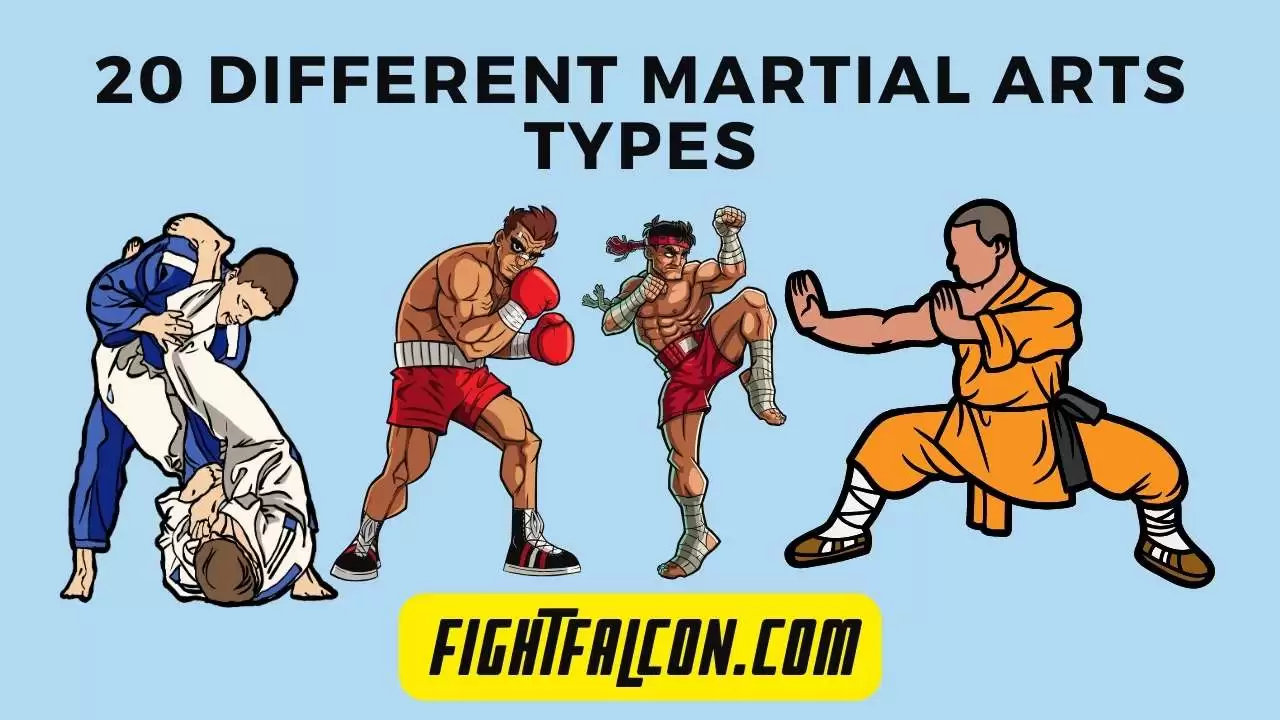
1. Muay Thai
Muay Thai, also known as The Art of Eight Limbs, is an incredibly powerful martial art from Thailand’s heart. In this fascinating sport, fighters use not only their fists and feet but also their knees and elbows to engage with their opponents, creating a tense and action-packed battle in which each decision holds significance.
History and Recognition
The rich history of Muay Thai can be traced back to historic times when Thai soldiers used these fighting talents for military purposes. Over the centuries, it has developed into a wonderful martial art that blends strength and quickness.
What sets Muay Thai apart is its complex positioning strategies. Practitioners master the art of striking swiftly and powerfully, using punches, kicks, and the precision of knees and elbows. It’s more than brute force: a careful balance of method and timing.
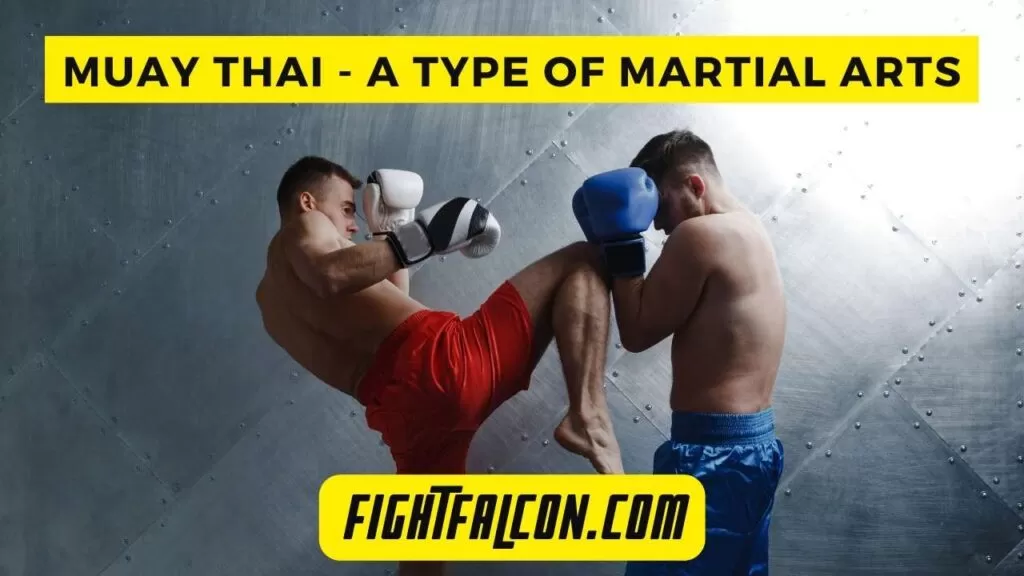
Muay Thai is more than just a sport in Thailand; it is a way of life. Every match is a performance, with rituals that pay tribute to the art and the fighting parties, reflecting their deep appreciation and cultural significance.
The Popularity of Muay Thai
Muay Thai has become famous worldwide, and you can find places to study and practice it in many nations. Thai fighters are recognized for their incredible capabilities, specifically in Mixed Martial Arts (MMA).
Besides being a form of entertainment, Muay Thai is also practical for self-defense. Learning Muay Thai can give you the skills to guard yourself if needed.
Training in Muay Thai is hard. Fighters work hard to become robust and speedy. They also learn how to defend themselves; that’s just as important as attacking.
Recently, Muay Thai has become popular at events like the ONE Championship and the UFC. Fighters who use Muay Thai are recognized for their striking capabilities.
Muay Thai is a great way to stay in shape and learn self-defense, and watching sports activities like MMA is interesting.
2. Kung Fu
Traditional Kung Fu, additionally known as Chinese martial arts, holds charming and rich records as a fighting form that originated in China. It’s a martial art handed down through generations, keeping its historical roots.
Techniques of Kung Fu
In the world of Traditional Kung Fu, practitioners delve into a variety of techniques for both offense and defense.
These techniques are frequently linked to the quick movements and behaviors of wildlife, including tigers, snakes, and cranes, making Kung Fu a martial art and a deep connection with the natural world.
One of the cornerstones of Traditional Kung Fu is determination. Practitioners commit themselves to regular training, learning challenging rules and strategies. It’s not simply fighting; it’s a journey of self-control and profound recognition.
Kung Fu places brilliant emphasis on balance and adaptability. Training consists of activities that enhance physical power, agility, and coordination. This martial art isn’t only physically traumatic but also mentally challenging.
In China, Traditional Kung Fu is deeply intertwined with lifestyle and philosophy. It embodies values like respect for the community, honor, and humility. Many Kung Fu schools teach their students the physical components and ethical and moral standards.
Modern Popularity of Kung Fu
Traditional Kung Fu has gained global recognition. It goes above and beyond combat and serves as a means to stay fit and improve your sense of well-being. Many people exercise Kung Fu as a form of exercise and a method to help relieve stress.
Recently, Kung Fu has ventured into film and become a famous way of life. Iconic actors Bruce Lee and Jackie Chan have added the beauty and electricity of Traditional Kung Fu to the massive display, fascinating audiences worldwide.
It’s not just about fighting; it’s about building a connection with nature, cultivating strength of will, and embracing the values of a lifestyle. Kung Fu is a holistic exercise that enriches the body and the mind.
Want to Learn Kung Fu – Watch The Video
3. Judo
Judo, also known as the “gentle way,” traces its roots back to Japan. It stands proud amongst martial arts for its philosophy of using an opponent’s strength and power against them instead of relying completely on one’s physical ability.
Techniques of Judo
In Judo, the ultimate goal is to throw or incapacitate your adversary. Forget striking or punching; this is a dance of power and balance. Here, practitioners emerge as specialists at harnessing their opponent’s movements and momentum to get the upper hand.
At the heart of Judo lies the principle of “Ju,” which translates to gentleness. It gives its practitioners the art of being adaptable and flexible when faced with the opponent’s force. This very philosophy sets Judo apart from all other martial arts.
Judo’s training method is painful and involves rigorous throws, grappling, and groundwork exercises. Yet it’s not just about the bodily elements; it’s also about building self-awareness, appreciation, and etiquette. Bowing and displaying admiration for your training partners and instructors are essential to the Judo tradition.
Competitions
Judo practitioners strive to attain points in the competition through skillful throws and expert holds. There are rules and regulations to ensure the protection of all members, making Judo a unique combination of entertainment and martial arts. Here, the spotlight shines on skill and technique rather than brute force.
But Judo is more than just a sport; it is a route to self-improvement and personal growth. It imparts values like perseverance and humility, which go a long way beyond the confines of the dojo (school hall) into our daily lives.
Judo has found a place in the Olympic Games and established itself as a worldwide phenomenon. It’s no longer simply a martial art; it’s a competitive field that draws in members and fans from every corner of the globe.
Watch the Video and learn more About Judo
4. Capoeira
Originating from Brazil, Capoeira stands out as a martial art combining dance and fighting elements. It’s not just about using your hands and feet; it’s about engaging your entire body. Often known as a “game,” Capoeira gives off a playful and creative spirit.
The Art of Capoeira
Capoeiristas match their movements with the tune, seemingly dancing, but on the floor, it’s deeply rooted in African traditions as a proper martial art.
What sets Capoeira apart is its ability to be clever. Capoeiristas are masters of deception, making difficult dodges and spins that keep their opponents guessing. It’s a strategic and unpredictable game.
The ancient importance of Capoeira in Brazil is significant. It emerged among African slaves brought to Brazil to resist their oppressors. Cleverly disguised as a dance, Capoeira allowed them to remain undetected. It stands today as a powerful image of freedom and resilience.
To excel in Capoeira, one must possess both physical energy and fluidity. It takes long-term practice to gain talent. But it’s not just the bodily component; Capoeira also conveys significant lifestyle values, including respect, subjectivity, and creativity.
Diversity of Capoeira
In the present day, Capoeira has broadened its reach, achieving recognition around the globe. Capoeira colleges and communities have been established in several international locations, attracting enthusiasts of all ages. It serves as a source of entertainment, fitness, and cultural appreciation.
In Capoeira, there are no winners or losers. Instead, it celebrates the art, the journey, and the sense of community it fosters. Capoeira unites humans from numerous backgrounds, and this feeling of togetherness makes it remarkable.
5. Jiu-Jitsu
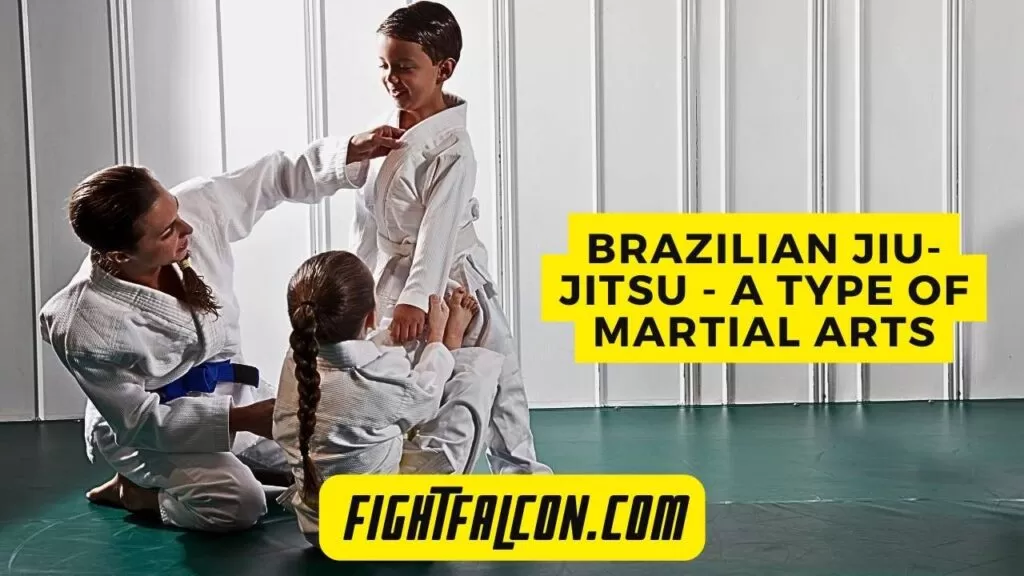
Brazilian Jiu-Jitsu, fondly called BJJ, originates from the coronary heart of Brazil. It’s an art of combat that revolves around ground combat, putting it aside from different martial disciplines, which emphasize striking strategies.
In BJJ, the essence lies in using movements like joint locks and chokeholds to assert dominance and force your opponent to submit. Think of it as a chess game where you cunningly outmaneuver your adversary through skill and leverage.
Flexibility in Jiu-Jitsu
One of the most fascinating elements of BJJ is its open-mindedness. Unlike a few sports that focus on strength and size, BJJ is an arena where all of us can excel. It’s a realm where you successfully harness the energy of your bodies and minds. This is why people of every age and stature greatly enjoy training BJJ.
BJJ imitates the process of problem-solving on the mat. You grasp the art of defending yourself, even when you find yourself in your lower back. It’s no longer about sheer aggression; it’s about cleverness and strategic thinking.
Training in BJJ
BJJ training provides an excellent health regimen. It complements your flexibility, fortifies your physical strength, and refines your ability to control your body. Moreover, it is an empowering way of building self-confidence and establishing a sense of safety.
The combat jiu-jitsu has solidified its position within combined martial arts (MMA). Countless MMA combatants have BJJ in their arsenal because of its extraordinary effectiveness when the motion hits the floor. BJJ tournaments also gained a tremendous reputation, allowing practitioners to test their abilities against peers.
Within the world of BJJ, an unbreakable bond of respect and gratitude exists. The “BJJ family” is frequently called because the community feels close-knit and supportive. People rally together to help one another succeed, developing a warm and uplifting environment.
6. Hapkido
Hapkido is a Korean martial art that demonstrates how to use an opponent’s energy to develop a harmonious approach to self-defense.
Concept of Hapkido
In Hapkido, practitioners immerse themselves in various strategies, from effective moves and joint locks to throws and the skilled usage of weaponry. This martial art form is incredibly adaptable, with a strong emphasis on versatility and fluidity of motion.
What sets Hapkido apart is its commitment to rhythmic movements. Rather than being subjected to extreme pressure, Hapkido practitioners use it to their advantage, creating a captivating dance of self-defense.
Within the area of Hapkido, there is great respect for people of all kinds. Traditions that include bowing and demonstrating admiration to instructors and training partners are deeply rooted. It’s a practice that extends beyond physical skill to mental and moral improvement.
Diversity of Hapkido
Hapkido is also very practical; it is your go-to resource for self-defense in real-world situations. It doesn’t use violence; instead, it fosters an experience of preparedness and confidence in oneself.
While immersed in Hapkido education, you go on a physically traumatic journey. It shapes you into a beast, giving you power, flexibility, and agility while perfecting your balance and coordination.
The popularity of Hapkido speaks for itself. Schools and organizations have developed in numerous nations from North to South and East to West. People from all walks of existence, no matter their age or historical past, are drawn to Hapkido not only for self-defense but also for health and, most significantly, for personal growth.
7. Krav Maga
Krav Maga is a martial art truly about good self-defense. It does not focus on fancy actions or rituals; it’s about safely escaping dangerous conditions.
In Krav Maga, you learn strategies to shield yourself from real-life events. It’s not about fighting for sport but defending yourself and others in case you’re ever at risk.
Benefits of Krav Maga
One of the cool things about Krav Maga is its simplicity. You don’t need to be extremely athletic or have years of education to use it efficiently. Krav Maga teaches you to react quickly and decisively.
Krav Maga is used by the Navy and law enforcement agencies worldwide. It’s known for its efficiency and effectiveness in high-stress conditions. It is a straightforward approach to self-defense.
Training in Krav Maga:
Training in Krav Maga is severe but beneficial. You’ll discover ways to cope with threats, from clutches and grasps to armed attackers. It’s an incredible way to boost your self-assurance and stay secure.
There’s a strong emphasis on awareness and prevention in Krav Maga. You’ll discover ways to spot potential dangers and avoid them whenever possible. The best fight is the only one you don’t have to have.
Krav Maga is likewise a brilliant workout. It lets you get in shape, enhance your endurance, and build mental strength. Plus, it is an ability that can save lives.
8. Taekwondo
In Taekwondo, the focus revolves around studying the art of kicking. Fighters interact through intense training, perfecting their capabilities in high kicks, spinning kicks, and lightning-fast strikes. It has a pattern of powerful kicks as well as some jabs.
Benefits of Taekwondo
What makes Taekwondo top-tier is its transformative impact on the body. Through dedicated practice, practitioners add energy and versatility and refine their mental and physical balance. Beyond the area of combat, Taekwondo serves as a powerful fitness regimen.
Taekwondo’s importance continues to grow worldwide. It’s an Olympic sport. It is practiced by people worldwide and finds its purest form in competitive arenas where individuals showcase their outstanding skills.
However, Taekwondo isn’t solely about bodily fitness; it’s deeply rooted in the values of appreciation and area. Instructors and fellow trainees are greeted with a humble bow, and adhering to strict standards of behavior is the most important thing. It’s a show of appreciation as well as an unwavering dedication.
Journey in Taekwondo
Progressing in Taekwondo involves earning specific colored belts, starting with the humble white belt and ending with the prestigious black belt. Each belt represents a testament to one’s strength and willpower within the discipline.
Taekwondo goes beyond the bodily realm; it delves into the realms of mental power. Alongside mastering the art of kicking, practitioners develop mental discipline, enhancing their understanding of the art and their self-assurance.
Watch This Amazing Video About Taekwondo Skills
9. Aikido
Originating in Japan, Aikido is a martial art that revolves around harmony and balance to protect oneself while avoiding harm to the opponent.
In Aikido, the point of interest isn’t going head-to-head with an opponent’s power. Instead, it is like a swish dance, where you seamlessly connect with their actions and use your strength in a masterful show of defense.
Non-Violent Philosophy of Aikido
What makes Aikido special is its profound philosophy of non-violence. Here, you do not learn how to assault; you discover ways to shield. It’s about discovering peaceful resolutions to conflicts as they arise.
Aikido techniques contain artful throws and specific joint locks. Striking and kicking isn’t the essence here; it is about skillfully guiding your opponent’s motions gently but highly effectively.
The respect and care for others embedded in Aikido schooling are fundamental. You express your gratitude and appreciation by bowing to your instructors and education partners. It’s more than just bodily skill; it is a mental and ethical growth journey.
Benefits of Aikido
Through Aikido, you develop the ability to remain calm and focused, even when faced with the most traumatic conditions. This exercise teaches you the art of staying focused and balanced on and off the mat.
At its core, Aikido champions the concept of self-protection without inflicting damage on your opponent. It’s a martial art deeply rooted in compassion and empathy.
Aikido is open to people of all ages and backgrounds, imparting an extremely good approach to enhancing bodily health, boosting self-confidence, and fostering a positive attitude.
10. Wing Chun
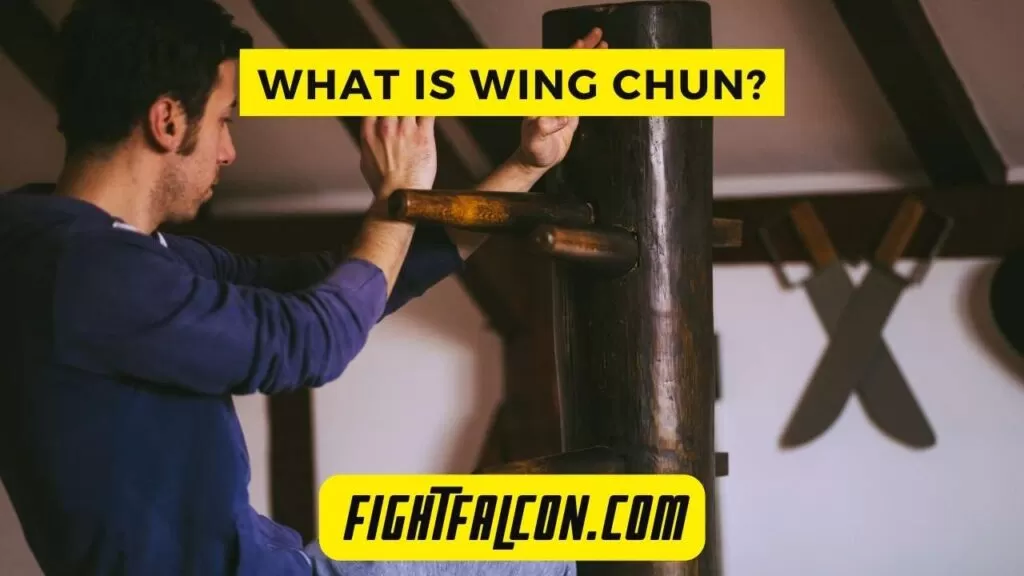
Originating from China, Wing Chun stands out as a martial art famous for its lightning-fast, precise attacks. This style of kung fu focuses on close-quarters combat and the art of efficiency.
In the world of Wing Chun, you harness your body’s energy in an immediate and streamlined manner. The essence here isn’t excessive or flashy maneuvers but rather the desire for speed and accuracy. Wing Chun’s techniques are simple yet enormously powerful.
Benefits of Wing Chun
What sets Wing Chun apart is its recognition of using an opponent’s power for your benefit. In a fast-paced fight, you can dodge incoming attacks and counter with punches and kicks.
An important part of Wing Chun training involves knowing how to do things, which are the building blocks for learning the art. These rules strengthen muscle memory and elevate your reflexes to new heights.
At the heart of Wing Chun lies the idea of the centerline principle. This fundamental principle dictates that you direct your attacks toward the centerline of your opponent’s body to maximize efficiency—a tactical method of combat.
Training in Wing Chun
Wing Chun also places great importance on sensitivity training, which teaches you to recognize and manage your opponent’s movements. This consciousness lets you respond quickly and adapt seamlessly to numerous scenarios.
Training in Wing Chun is full of discipline and respect. A bow to your teachers and training partners is a sign of regard, symbolizing that it encompasses more than just physical prowess. It’s a world in which wisdom and humbleness are equally important.
Wing Chun is a martial art accessible to people of every age and body type. It is a practical and effective self-defense system that doesn’t rely on brute force, making it an artwork that gives people power and security.
11. Karate
Japan brought out karate, which stands out as a martial art known for its powerful and graceful striking methods and a strong desire for the art among the practitioners.
In Karate, practitioners are taught a variety of strikes, including jabs, kicks, and knee moves. Given equal strength and skill, these moves effectively combine attacks and protective blocks.
Getting the Form
One of the charming aspects of Karate lies in its passion and drive to master the Kata (form). These forms serve as the foundation for developing skills and enhancing performance. It corresponds to a solo performance where one imagines facing off against imaginary adversaries.
Karate goes far beyond the boundaries of combat; it’s an approach grounded in self-control and respect.
Training in Karate
The demands of karate training affect the body, transforming individuals into people who are healthy and full of energy. Beyond improving one’s physical abilities, it promotes balance and coordination. Here, it’s no longer about refining the body; it’s also about sharpening the mind.
Karate is a martial art that welcomes people of numerous ages and backgrounds, imparting a means to strengthen self-belief and build resilience in one’s mind.
Karate is made up of a variety of techniques and abilities, each of which has its precise strategies and traditions. However, at its core, Karate is a tribute to discipline, recognition, and striking mastery.
Learn Karate Basics – Watch the Video
12. Jeet Kune Do
Jeet Kune Do (JKD) is a martial art that champions simplicity and adaptability above all else.
This excellent fighting method can trace its origins to the legendary Bruce Lee, a visionary who aimed to craft a martial art custom-made for genuine fight events.
Concept of JKD
At the core of JKD lies the idea of using what proves effective and eliminating what is no longer effective. There are no rigid rules or strategies that constrain those who use them; as an alternative, it inspires them to forge their route, always ready to adjust to the changing dynamics of a confrontation.
Within the world of JKD, the centerline is of the utmost importance. Imagine an invisible axis running through your body; in JKD, mastery of this line empowers practitioners to seize an edge over their adversaries. By keeping their attention on the centerline, JKD fighters adeptly launch attacks and guard themselves, all while maintaining control.
Yet JKD’s training goes beyond the physical; it delves into mental growth. Bruce Lee heavily emphasized the importance of mental coaching and attention in fighting. JKD trainees are encouraged to cultivate open-mindedness and an unquenchable thirst for self-improvement.
Flexibility of JKD
JKD refuses to stick to a specific set of rules or techniques and chooses instead to draw from a wealthy collection of martial arts and fighting patterns. This flexibility empowers practitioners to pick out techniques that go with their natural abilities and needs in the given situation. It’s a combination of fluidity and flexibility in the heat of combat.
In JKD, the principle of “economy of motion” reigns supreme—harnessing the fastest and most efficient moves to achieve one’s goals. This philosophy resonates with Bruce Lee’s famous quote: “Absorb what is useful, discard what is not, and add what is uniquely your own.”
Bruce Lee’s Jeet Kune Do goes beyond the label of a simple martial art because it manifests as a way of life. It imparts a fundamental belief system that encourages its followers to confront challenges with open-mindedness, adaptability, and an unwavering dedication to private growth. This philosophy goes a long way beyond the confines of the school, affecting all aspects of our lives.
13. Eskrima (Arnis)
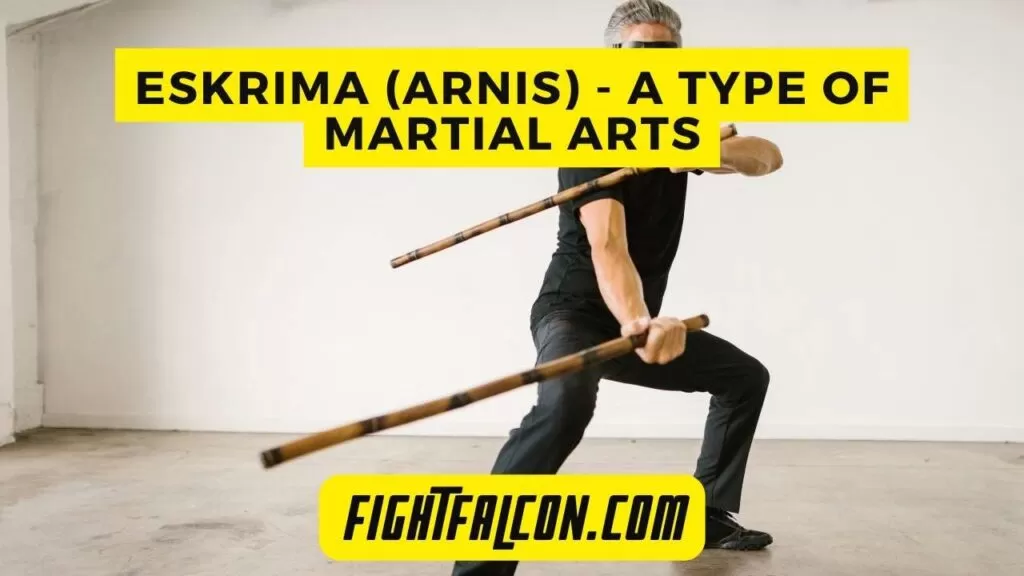
Eskrima, also known as Arnis or Kali, is a long-standing Filipino martial art with origins cultivated through the centuries. What distinguishes Eskrima from other martial arts is its unwavering recognition of combat involving weaponry, specifically sticks, knives, and many bladed weapons.
Concept of Eskrima
At its essence, Eskrima revolves around the mastery of weaponry for self-protection. Practitioners delve into the artwork of wielding sticks, frequently called “arnis” or “bastons,” with a mix of speed, precision, and bold strength.
The fluid, complicated movements are unique to Eskrima are expertly designed to effectively disarm adversaries and maintain full command over the flow of combat.
One of the most fascinating features of Eskrima lies in its adaptability. It allows you to seamlessly transition between armed and unarmed combat situations, forming a complete system for self-protection. Eskrima practitioners are taught how to transform ordinary gadgets into improvised weapons, stressing the importance of being resourceful in all situations.
Training in Eskrima
Eskrima training regularly includes “sparring” sessions, in which practitioners engage in managed combat using sticks made of rattan or foam. This approach allows for the practical application of strategies while reducing the risk of mishaps.
While Eskrima is given most credit for its systematic use of weapons, it doesn’t forget empty-hand combat and grappling. This comprehensive approach ensures that practitioners are well-prepared to handle various combat situations.
Eskrima remains very much present in Filipino society and is a useful talent for personal protection. Recently, this ancient art has gained international popularity, attracting practitioners from all over the world eager to learn about its rich history and functional fighting methodologies.
14. Sambo
Sambo, a martial art from the heart of Russia, stands as a versatile and dynamic fighting technique developed in the early 20th century. This practice masterfully blends elements from various martial arts, creating a complete approach to fighting and self-defense.
At its core, Sambo represents a precise combination of practicality and creativity. It was initially crafted to equip Russian soldiers with effective hand-to-hand fighting abilities. Over time, it transformed into a thrilling, aggressive sport and a complete martial art.
Defensive and Offensive
A defining characteristic of Sambo lies in its universality. It covers all aspects of defensive measures, strongly emphasizing grappling techniques. Sambo practitioners, known as “Sambists,” become masters of leverage and strategy, using them precisely in sporting events and real-life self-defense situations.
Sambo competitions are nothing less than captivating events. Sambists flaunt their skills with throws, pins, joint locks, and strangles. Unlike some martial arts that emphasize the use of force, Sambo emphasizes ground-based control and submission techniques.
What genuinely sets Sambo apart is its adaptability. While it takes pride in its roots in conventional techniques, it fosters an environment for innovation and creativity. This empowers sambists to sharpen their abilities and craft new strategies that shock their combatants.
Within the realm of Sambo, a robust sense of fellowship exists among practitioners. They are referred to as the “Sambo family.” This spirit of sportsmanship and mutual recognition extends beyond the mat and into the larger Sambo network.
Sambo’s versatility has made it a name in Russia and internationally. It has developed into an imperative aspect of Mixed Martial Arts (MMA) schooling, with its ground-breaking techniques proving useful in the cage.
The exercise of Sambo stands as a testament to Russia’s wealthy records and unbreakable combat spirit. Sambo is the answer whether you are looking for self-defense skills, a thrilling competitive game, or a truly hard and immersive martial art.
15. Kendo
Kendo, also called “the way of the sword,” is a traditional Japanese martial art specializing in disciplined sword combat. It’s not just a hobby or a self-protection technique; it’s a way of life deeply linked to Japan’s history and subculture.
Techniques of Kendo
At its core, Kendo includes using bamboo swords (called shinai) and shielding tools (bogu) for combat. People who exercise Kendo, known as “Kendoka,” try to score points by accurately hitting unique areas on their opponent’s body. These areas encompass the head, wrists, and torso.
A massive aspect of Kendo is its focus on manners and respect. Before every match, Kendoka bow to each other and show respect to their teachers. This highlights the significance of being humble and showing good sportsmanship.
Kendo isn’t always just about bodily movements but specializes in intellectual areas. Kendoka educates to acquire a state of “Mushin,” which means having a clean mind with no thoughts of your own while engaged in combat. This mental clarity allows them to react quickly and make choices quickly.
Training in Kendo
Kendo training is hard and requires a lot of effort. Kendoka exercises numerous routines (kata) that contain unique sequences of strikes and defenses. These routines help students examine the right strategies and timing. Sparring, or “Keiko,” is an important part of Kendo education, where practitioners can use their skills in a controlled but realistic setting.
Kendo has deep roots in Japan’s history and samurai way of life. It developed from conventional sword combat techniques and has its origins in Kenjutsu. Over time, Kendo became more common and accessible, making it available to various people.
16. Tai Chi (Taijiquan)

Tai Chi, also known as Taijiquan, is a centuries-old Chinese martial art that has caught people’s attention from all corners of the globe. Its slow, effortless movements and profound fitness benefits have earned it a special place in the hearts of enthusiasts. At its core, Tai Chi is about finding peace in your mind, body, and spirit.
Concept of Tai Chi
Imagine Tai Chi as a moving meditation. Its planned, fluid motions are designed to boost mental alertness, making it possible to find balance and a state of calm. Tai Chi is not only a martial art; it’s a way of life.
One of Tai Chi’s fundamental concepts revolves around “Qi” (pronounced “chee”), representing the essential power of energy that flows through our bodies. Tai Chi practitioners are searching for ways to harmonize and expand the flow of Qi and improve their general health and well-being.
Tai Chi’s moves are slow and easy, emphasizing relaxation and firmness. This sets it apart from many martial arts, prioritizing speed and force. Tai Chi encourages people to submit to pressure rather than resist it, showing the essence of soft power.
Tai Chi styles, also known as routines, consist of carefully planned movements. These structures are at the heart of Tai Chi exercise, from quick to simple to complicated and extensive.
Benefits of Tai Chi
Beyond its mental and spiritual blessings, Tai Chi impacts physical health profoundly. Regular practice helps with balance, flexibility, posture, and coordination. It’s often recommended for older people because it’s a way to prevent accidents and maintain one’s balance.
Tai Chi’s focus on unhurried, managed motions makes it accessible to individuals of every age and fitness stage. You can exercise it within a group or individually, indoors or outdoors, making it an adaptable and convenient martial art.
17. Wushu
Wushu, also known as Chinese martial arts, comes from China. It has a lot of moves and styles, making it one of the most versatile and eye-catching martial arts in the world.
In Wushu, you make smooth and fancy moves like high kicks and routines. These routines are like artistic performances and are also part of competitions.
What’s neat about Wushu is that it’s tied to China’s old stories and beliefs. People who do Wushu not only learn to fight but also connect with Chinese culture.
The competitions have two main types: one where you do fancy routines (Taolu) and another where you fight like kickboxing.
Training in Wushu is hard work. You need to get flexible and strong and keep your balance. Getting good takes a long time, and you need experienced teachers to help you. Wushu also teaches you to be focused and calm.
This martial art isn’t just about fighting; it’s also a kind of entertainment. People worldwide love watching Wushu performances, even at big events like the Olympics.
18. Boxing,
Also known as “the sweet science,” it is among the world’s oldest and most respected combat sports activities. It’s recognized for its powerful punches and has many record-setting performances that attract fans and fighters today.
At its center, boxing is about punching. Fighters use jabs, hooks, uppercuts, and crosses to hit their opponent while avoiding getting hit themselves. The goal is simple: land punches while not getting hit.
Objective of Boxing
What makes boxing special is its focus on skill and approach. Boxers learn how to move their feet and heads and guard themselves to avoid punches while finding possibilities to land their own. People often compare boxing to a chess match, requiring physical strength and clever thinking.
Boxing matches, also known as “bouts,” happen in a ring with a referee to keep things fair and secure. Fighters wear gloves and are grouped by weight classes to make the fights equal. Bouts can go for several rounds, and every round has a fixed time.
Boxing stands proud as it is popular worldwide and is even part of the Olympics. Famous boxers like Muhammad Ali, Mike Tyson, and Floyd Mayweather Jr. Have become well-known for their competencies and personalities.
Training and Benefits
Boxers require intensive training. They work on their endurance, pace, and power, all necessary for attacking and defending.
Beyond the competitive aspect, many people enjoy boxing to stay healthy and relieve pressure. Boxing gyms offer lessons for folks who want to get in shape and study the fundamentals of boxing without competing.
In boxing, there is a strong tradition of respect. Fighters regularly touch gloves at the start of a fight and show appreciation for their opponents, whether or not they win or lose. This feeling of appreciation goes out to the entire boxing community.
19. Kickboxing
Kickboxing stands as a martial arts and fight sport that merges the finesse of boxing with the powerful strikes and kicks associated with karate and Muay Thai. It’s an exciting and physically demanding sport known for its highly competitive methods and comprehensive training program.
Objectives of Kickboxing
At its heart, kickboxing revolves around unleashing forceful strikes with fists and legs while maintaining an unwavering grasp on power and control. Individuals who master this field, known as kickboxers, dedicate themselves to mastering a variety of punches, kicks, knee and elbow moves.
A major advantage of kickboxing is its ability to adapt. Kickboxers excel in punching and kicking, allowing them to deal with situations in the ring or self-defense encounters. This adaptability supports kickboxing as a complete martial art.
Competitions in Kickboxing
Kickboxing competitions, whether or not in the form of full-contact, semi-contact, or light-contact matches, are thrilling experiences for both spectators and fighters. These contests highlight the fusion of striking skills and protection techniques that define this martial art.
Fighters attempt to beat their opponents or deliver knockout blows while adhering to the rules and regulations of their chosen kickboxing style.
Training and Benefits
The intensive training in the art of kickboxing focuses on improving one’s physical fitness and enhancing cardiovascular health, strength, pace, and agility. Kickboxers develop strong leg muscles and a strong spine, which are necessary for delivering powerful kicks while preserving their balance.
However, kickboxing goes beyond mere physical strength; it places a lot of emphasis on technique and method. Fighters must be able to read their opponents, detect gaps in their defenses, and execute precise combinations. This martial art calls for both mental sharpness and bodily strength.
Beyond its competitive realm, kickboxing has gained a reputation as a popular health activity. Many follow kickboxing instructions to improve physical fitness, boost self-assurance, and reduce stress. The training methods and workout strategies make it enjoyable to get in shape.
20. Mixed Martial Arts (MMA)

Imagine a world where fight sports combine all the fighting styles of Martial Arts. That’s exactly what Mixed Martial Arts (MMA) is all about. MMA has grown to be a popular sport internationally because it’s a combination of various fighting styles. This way, fighters can use various moves to try to win.
Concept of MMA
At its core, MMA combines punches, kicks, and grappling from numerous fighting styles like
Muay Thai, Boxing, Brazilian Jiu-Jitsu, wrestling, and more. The fighters use a mixture of these punches, kicks, takedowns, and submission holds to beat their opponents.
MMA is so cool that fighters should be top at both standing and ground fighting. They must be well-rounded. MMA matches show up in a special eight-sided ring called the Octagon, which makes the fights even more exciting.
Like those in the Ultimate Fighting Championship (UFC), MMA fights have policies to keep everyone secure and ensure things are fair. Each round lasts five minutes, and opponents use defensive tools like gloves and mouthguards.
One of the thrilling things about MMA is that you never realize what will happen next. Fighters come from different backgrounds, so each match combines strategies and techniques. MMA fights can end in different ways, like a knockout, a submission, or a judge’s decision. Read more here about martial arts types and categories.
Training in MMA
Training for MMA is difficult and requires quite a lot of hard work. It includes getting sturdy, improving your stamina, and studying how to punch and grapple. Fighters need to be in good shape to handle all of the demanding situations of the game.
But MMA isn’t always just for those who want to fight. It’s also an amusing way for ordinary people to get fit and learn self-defense. Lots of gyms offer education for all skill levels and fitness goals.
How Do You Choose a Martial Art to Learn?
The martial art you should choose depends on your goals, interests, and physical abilities. For self-defense, Krav Maga, Jiu-Jitsu, and Judo are excellent choices.
If you are interested in striking, you might enjoy Kickboxing, Karate, Taekwondo, or Boxing. Tai Chi can be a great choice for fitness due to its low impact, gentle movements, and mental focus.
Watch the Video to Learn More!
Is It Difficult to Learn Martial Arts?
The difficulty level of learning martial arts depends on the style, the teacher, and the individual. Some martial arts can be physically demanding and require substantial time to learn the techniques and movements effectively.
However, martial arts are accessible to people of all ages and abilities, and a good teacher can help you progress at your own pace.
Is It Safe to Practice Martial Arts?
Like any physical activity, practicing martial arts can pose some risks. However, with proper training and technique, the likelihood of injury is significantly reduced.
Training with a qualified instructor who can guide you and ensure your safety during practice is always essential.
Conclusion
Martial arts are a world of discipline, range, and self-discovery. Each style has its particular path to physical and mental growth.
Whether you are pursuing physical fitness, self-protection, or growth in the competitive nature of the sport, martial arts has something to offer every one of us.
So, take the first step on this fantastic journey and discover your true potential through the martial arts world.

